Inspection
Brake pads
Caution! Direct contact of DOT 4 brake fluid with eyes can cause irritation. Avoid eye contact. In case of eye contact flush with large amounts of water and get medical attention. Swallowing large amounts of DOT 4 brake fluid can cause digestive discomfort. If swallowed, obtain medical attention. Use in well ventilated area. KEEP OUT OF REACH OF CHILDREN.
Notice: DOT 4 brake fluid will damage painted and body panel surfaces it comes in contact with. Always use caution and protect surfaces from spills whenever brake work is performed. Failure to comply can result in cosmetic damage.
Warning! Always replace brake pads in complete sets for correct and safe brake operation. Improper brake operation could result in death or serious injury.
See Figure 1-40. Replace brake pads if brake pad friction material on either the front or rear caliper is worn to 0.04 in (1.02 mm) or less (3) above the backing plate. Always replace both pads in a caliper as a set. See 1.16 BRAKE PADS AND DISCS: XL MODELS, Brake Pad Replacement: Front or 1.16 BRAKE PADS AND DISCS: XL MODELS, Brake Pad Replacement: Rear.

Figure 1-40. XL Brake Pad MIN Thickness: 1. Front, from below; 2. Rear, from above; 3. MIN thickness
When checking the brake pads and discs, inspect the brake hoses for correct routing and any signs of damage or leakage.
Brake disc thickness, lateral runout and warpage
See Figure 1-41. The minimum brake disc thickness is stamped on the side of the disc. Replace disc if worn past minimum thickness or badly scored.

Figure 1-41. Brake Pads and Discs: 1. Front brake caliper (from below); 2. Brake disc; 3. Brake pad; 4. Brake pad backing plate; 5. Rear brake caliper (from rear)
Maximum brake disc lateral runout and warpage is 0.008 in (0.2 mm) when measured near the outside diameter.
To replace front brake disc(s), see 2.5 WHEELS, Front Wheel.
To replace rear brake disc, see 2.5 WHEELS, Rear Wheel.
Brake pad replacement: front
| FASTENER | TORQUE VALUE | |
| Brake pad pin | 131-173 in·lbs | 14.8-19.6 Nm |
| Brake pad pin plug | 18-25 in·lbs | 2.0-2.9 Nm |
| Brake master cylinder, front, reservoir cover screws | 9-17 in·lbs | 1.0-2.0 Nm |
Notice: DOT 4 brake fluid will damage painted and body panel surfaces it comes in contact with. Always use caution and protect surfaces from spills whenever brake work is performed. Failure to comply can result in cosmetic damage.
Notes:
- Do not remove front caliper(s) from mounting bracket unless caliper mounting pins require service. Caliper removal increases risk of contaminate damage.
- If DOT 4 brake fluid contacts painted surfaces, IMMEDIATELY flush area with clear water.
- Cover handlebar switches with a shop towel before adding brake fluid to front master cylinder reservoir. Spilling brake fluid on handlebar switches may render them inoperative.
1. Position motorcycle so that front master cylinder reservoir is level.
2. See Figure 1-42. Remove two screws (5), reservoir cover (4), diaphragm plate (3) and diaphragm (2) from master cylinder reservoir (1).

Figure 1-42. Front Brake Master Cylinder Cover Assembly (typical): 1. Front brake master cylinder assembly; 2. Diaphragm; 3. Diaphragm plate; 4. Reservoir cover; 5. Captive screw (2)
3. Wrap a shop towel around the master cylinder reservoir to contain any brake fluid spills.
Note. As the pistons are pushed back into the caliper, fluid level may rise higher than fluid level mark at about 1/4 in (6.35 mm) below top of reservoir. You may have to remove fluid to allow for this.
4. Press against the side of the brake caliper body to push the outside brake pad (pad closest to caliper pistons) back. This pushes the caliper pistons back into their bores.
Notes:
- See Figure 1-43. Verify that the pad spring is installed before installing the new pads.
- Front and rear brake caliper pads are not interchangeable.

Figure 1-43. Front Caliper Pad Spring
5. See Figure 1-44. Remove pad pin plug (3).

Figure 1-44. Front Caliper Assembly: 1. Front brake caliper; 2. Caliper mounting bracket; 3. Pad pin plug; 4. Caliper mounting pins
6. See Figure 1-45. Loosen, but do not remove, brake pad pin.

Figure 1-45. Brake Pad Pin (plug removed)
Note. Do not completely remove brake pad pin from caliper during the next step. Completely removing pad pin at this time may cause difficulty during assembly.
7. Once the pistons have been fully retracted into their bores, pull pad pin part way until inside pad drops free. Note the pad's original orientation for replacement purposes.
8. See Figure 1-46. Install new inside brake pad (1) using same orientation as pad previously removed. Align mounting tabs.

Figure 1-46. Front Brake Pads: 1. Brake pad; 2. Front mounting tab; 3. Pad pin hole; 4. Front caliper mounting bracket; 5. Slot
9. While holding new inside pad in place, pull pad pin out and remove outside brake pad. Note the pad's original orientation for replacement purposes.
10. Install new outside brake pad using the same orientation as pad previously removed. Align mounting tabs.
11. Temporarily insert a 1/8 drill bit in caliper pad pin hole to hold both pads in place.
12. Inspect pad pin for grooving and wear. Measure pad pin diameter in an unworn area, and then in the area of any grooving or wear. If wear exceeds 0.011 in (0.28 mm), replace pin.
13. Press brake pads firmly up against pad spring. Remove drill bit. Install pad pin. Tighten to 131-173 in·lbs (14.819.6 Nm).
Note. If pad pin does not fit, check the following:
- You are using a set of pads, not two identical pads.
- Pad spring orientation must match Figure 1-43.
- See Figure 1-46. Fully seat mounting tabs (2) in slot (5).
- Push pads against pad spring before installing pad pin.
14. See Figure 1-44. Install pad pin plug (3). Tighten to 18-25 in·lbs (2.0-2.9 Nm).
Warning! After servicing brakes and before moving motorcycle, pump brakes to build brake system pressure. Insufficient pressure can adversely affect brake performance, which could result in death or serious injury.
15. Pump brake lever to move pistons out until they contact outside brake pad. Verify piston location against pad.
Caution! Direct contact of DOT 4 brake fluid with eyes can cause irritation. Avoid eye contact. In case of eye contact flush with large amounts of water and get medical attention. Swallowing large amounts of DOT 4 brake fluid can cause digestive discomfort. If swallowed, obtain medical attention. Use in well ventilated area. KEEP OUT OF REACH OF CHILDREN.
Notice: DOT 4 brake fluid will damage painted and body panel surfaces it comes in contact with. Always use caution and protect surfaces from spills whenever brake work is performed. Failure to comply can result in cosmetic damage.
Note. If DOT 4 brake fluid contacts painted surfaces, IMMEDIATELY flush area with clear water.
16. See Figure 1-47. Check brake fluid level in master cylinder. Add enough DOT 4 BRAKE FLUID to reservoir to bring fluid level even with ridge (1) cast into inside of reservoir, about 1/4 in (6.35 mm) below top edge.
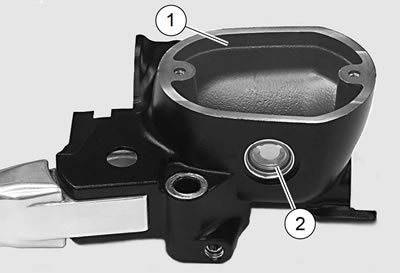
Figure 1-47. Filling Front Master Cylinder Reservoir (typical): 1. Cast-in ridge; 2. Sight glass
17. See Figure 1-42. Install diaphragm (2), diaphragm plate (3), reservoir cover (4) and screws (5) on front brake master cylinder reservoir. Tighten screws to 9-17 in·lbs (1.0-2.0 Nm).
Warning! After repairing the brake system, test brakes at low speed. If brakes are not operating properly, testing at high speeds can cause loss of control, which could result in death or serious injury.
18. Test brake system.
- a. Turn ignition switch ON. Pump brake lever to verify operation of the stop lamp.
- b. Test ride the motorcycle. If the brakes feel spongy, bleed the system. See 2.17 BLEEDING BRAKES.
Note. Avoid making hard stops for the first 100 mi (160 km). This allows the new pads to become conditioned to the brake discs.
Brake pad replacement: rear
| FASTENER | TORQUE VALUE | |
| Brake pad pin | 131-173 in·lbs | 14.8-19.6 Nm |
| Brake pad pin plug | 18-25 in·lbs | 2.0-2.9 Nm |
Notice: DOT 4 brake fluid will damage painted and body panel surfaces it comes in contact with. Always use caution and protect surfaces from spills whenever brake work is performed. Failure to comply can result in cosmetic damage.
Notes:
- See Figure 1-50. Do not remove or loosen the caliper mounting pins (4). Removing caliper from mounting bracket increases the risk of contaminants falling into caliper boots and bushings. These contaminants could damage caliper during vehicle operation.
- If DOT 4 brake fluid contacts painted surfaces, IMMEDIATELY flush area with clear water.
1. Position vehicle on a flat level surface.
Note. See Figure 1-48. As the piston is pushed back into the caliper, fluid level may rise higher than the upper fluid level (3) in the reservoir (1). You may have to remove fluid to allow for this.
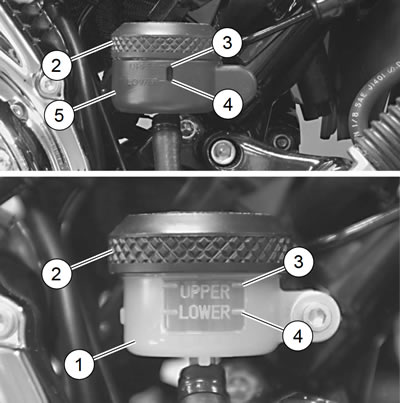
Figure 1-48. Rear Brake Master Cylinder Reservoir: XL Models: 1. Rear brake master cylinder reservoir; 2. Reservoir cap; 3. Upper fluid level; 4. Lower fluid level; 5. Reservoir cover
2. See Figure 1-48. Remove rear master cylinder reservoir cap (2).
3. Place a suitable container under the rear master cylinder to catch any fluid that may overflow.
4. Press against the side of the brake caliper body to push the outside brake pad (pad closest to caliper piston) back. This pushes the caliper piston back into its bore.
Notes:
- See Figure 1-49. Verify that the pad spring is installed before installing new pads.
- Front and rear brake pads are not interchangeable.
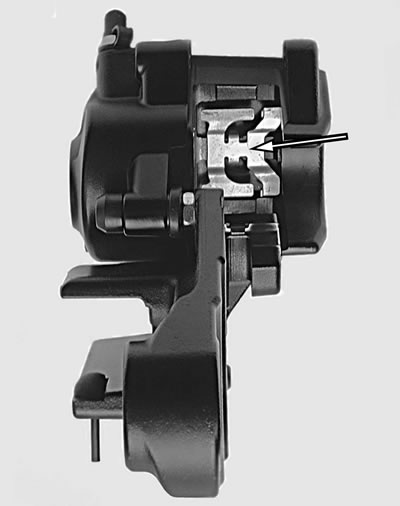
Figure 1-49. Rear Caliper Pad Spring
5. See Figure 1-50. Remove pad pin plug (3).

Figure 1-50. Rear Caliper Assembly: 1. Rear brake caliper; 2. Caliper mounting bracket; 3. Pad pin plug; 4. Caliper mounting pins
6. See Figure 1-51. Loosen, but do not remove, brake pad pin.
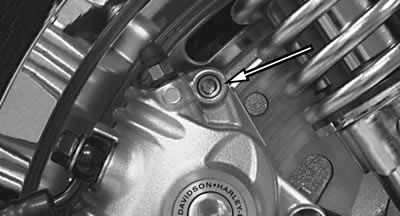
Figure 1-51. Brake Pad Pin (plug removed)
Note. Do not completely remove brake pad pin from caliper during the next step. Completely removing pad pin at this time may cause difficulty during assembly.
7. Once the piston has been fully retracted into its bore, pull pad pin part way until inside pad drops free. Note the pad's original orientation for replacement purposes.
8. See Figure 1-52. Install new inside brake pad (2) using same orientation as pad previously removed. Align mounting tabs.
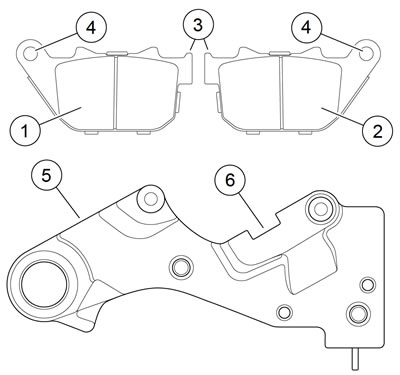
Figure 1-52. Rear Brake Pads: 1. Outside brake pad; 2. Inside brake pad; 3. Front mounting tab; 4. Pad pin hole; 5. Rear caliper mounting bracket; 6. Slot
9. While holding new inside pad in place, pull pad pin out and remove outside brake pad (1). Note the pad's original orientation for replacement purposes.
10. Install new outside brake pad using the same orientation as pad previously removed. Align mounting tabs.
11. Temporarily insert a 1/8-in (3.175 mm) drill bit in caliper pad pin hole to hold pads in place.
12. Inspect pad pin for grooving and wear. Measure pad pin diameter in an unworn area, and then in the area of any grooving or wear. If wear exceeds 0.011 in (0.28 mm), replace pin.
13. Press brake pads firmly up against pad spring. Remove drill bit. Install pad pin. Tighten to 131-173 in·lbs (14.8-19.6 Nm).
Note. If pad pin does not fit, check the following:
- You are using a set of pads, not two identical pads.
- Pad spring orientation must match Figure 1-49.
- See Figure 1-52. Pad front mounting tabs (3) must be fully seated in mounting bracket slot (6).
- Before the pad pin is installed, push pads up against the pad spring.
14. See Figure 1-50. Install pad pin plug (3). Tighten to 18-25 in·lbs (2.0-2.9 Nm).
Warning! After servicing brakes and before moving motorcycle, pump brakes to build brake system pressure. Insufficient pressure can adversely affect brake performance, which could result in death or serious injury.
15. Pump brake pedal to move piston out until it contacts outside brake pad. Verify piston location against pad.
Caution! Direct contact of DOT 4 brake fluid with eyes can cause irritation. Avoid eye contact. In case of eye contact flush with large amounts of water and get medical attention. Swallowing large amounts of DOT 4 brake fluid can cause digestive discomfort. If swallowed, obtain medical attention. Use in well ventilated area. KEEP OUT OF REACH OF CHILDREN.
Notice. DOT 4 brake fluid will damage painted and body panel surfaces it comes in contact with. Always use caution and protect surfaces from spills whenever brake work is performed. Failure to comply can result in cosmetic damage.
Notes:
- If DOT 4 brake fluid contacts painted surfaces, IMMEDIATELY flush area with clear water.
- Fill the rear brake master cylinder reservoir must be in a level position.
- See Figure 1-48. Reservoir cover (5) may be removed from rear brake master cylinder reservoir (1) to more easily verify fluid level in reservoir.
16. See Figure 1-48. If desired, remove rear brake master cylinder reservoir cover (5) by grasping cover and gently pulling it straight away from reservoir (1).
17. Check brake fluid level in master cylinder reservoir. If necessary, add DOT 4 BRAKE FLUID to reservoir until fluid reaches upper fluid level (3).
18. Replace master cylinder reservoir cap (2). Replace reservoir cover (5), if removed.
Warning! After repairing the brake system, test brakes at low speed. If brakes are not operating properly, testing at high speeds can cause loss of control, which could result in death or serious injury.
19. Test brake system.
- a. Turn ignition switch ON. Pump brake pedal to verify operation of the stop lamp.
- b. Test ride motorcycle at low speed. If the brakes feel spongy, bleed the system. See 2.17 BLEEDING BRAKES.
Note. Avoid making hard stops for the first 100 mi (160 km). This allows the new pads to become conditioned to the brake discs.
